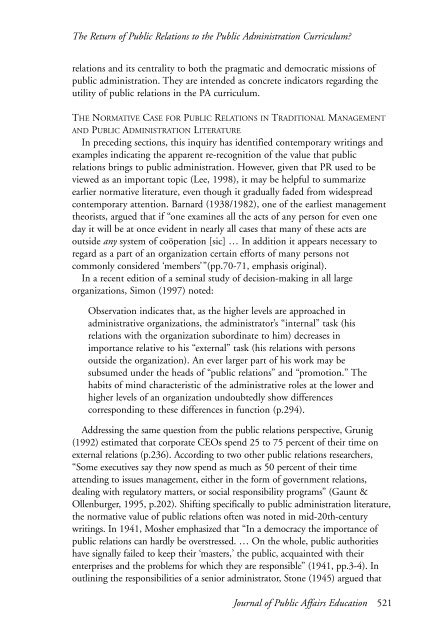JOURNAL OF PUBLIC AFFAIRS EDUCATION - National ...
JOURNAL OF PUBLIC AFFAIRS EDUCATION - National ...
JOURNAL OF PUBLIC AFFAIRS EDUCATION - National ...
You also want an ePaper? Increase the reach of your titles
YUMPU automatically turns print PDFs into web optimized ePapers that Google loves.
The Return of Public Relations to the Public Administration Curriculum?<br />
relations and its centrality to both the pragmatic and democratic missions of<br />
public administration. They are intended as concrete indicators regarding the<br />
utility of public relations in the PA curriculum.<br />
THE NORMATIVE CASE FOR <strong>PUBLIC</strong> RELATIONS IN TRADITIONAL MANAGEMENT<br />
AND <strong>PUBLIC</strong> ADMINISTRATION LITERATURE<br />
In preceding sections, this inquiry has identified contemporary writings and<br />
examples indicating the apparent re-recognition of the value that public<br />
relations brings to public administration. However, given that PR used to be<br />
viewed as an important topic (Lee, 1998), it may be helpful to summarize<br />
earlier normative literature, even though it gradually faded from widespread<br />
contemporary attention. Barnard (1938/1982), one of the earliest management<br />
theorists, argued that if “one examines all the acts of any person for even one<br />
day it will be at once evident in nearly all cases that many of these acts are<br />
outside any system of coöperation [sic] … In addition it appears necessary to<br />
regard as a part of an organization certain efforts of many persons not<br />
commonly considered ‘members’”(pp.70-71, emphasis original).<br />
In a recent edition of a seminal study of decision-making in all large<br />
organizations, Simon (1997) noted:<br />
Observation indicates that, as the higher levels are approached in<br />
administrative organizations, the administrator’s “internal” task (his<br />
relations with the organization subordinate to him) decreases in<br />
importance relative to his “external” task (his relations with persons<br />
outside the organization). An ever larger part of his work may be<br />
subsumed under the heads of “public relations” and “promotion.” The<br />
habits of mind characteristic of the administrative roles at the lower and<br />
higher levels of an organization undoubtedly show differences<br />
corresponding to these differences in function (p.294).<br />
Addressing the same question from the public relations perspective, Grunig<br />
(1992) estimated that corporate CEOs spend 25 to 75 percent of their time on<br />
external relations (p.236). According to two other public relations researchers,<br />
“Some executives say they now spend as much as 50 percent of their time<br />
attending to issues management, either in the form of government relations,<br />
dealing with regulatory matters, or social responsibility programs” (Gaunt &<br />
Ollenburger, 1995, p.202). Shifting specifically to public administration literature,<br />
the normative value of public relations often was noted in mid-20th-century<br />
writings. In 1941, Mosher emphasized that “In a democracy the importance of<br />
public relations can hardly be overstressed. … On the whole, public authorities<br />
have signally failed to keep their ‘masters,’ the public, acquainted with their<br />
enterprises and the problems for which they are responsible” (1941, pp.3-4). In<br />
outlining the responsibilities of a senior administrator, Stone (1945) argued that<br />
Journal of Public Affairs Education 521

















